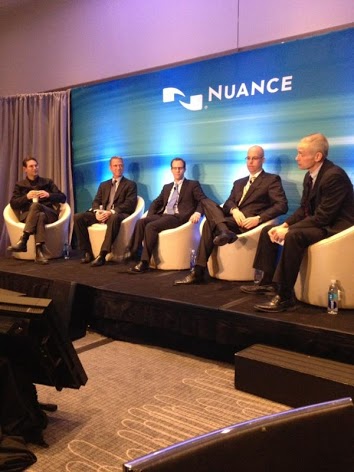 Left to Right: Halamka, Dreyer, Landman, Stack, and Weygandt.
Left to Right: Halamka, Dreyer, Landman, Stack, and Weygandt.
As regulatory efforts like ICD-10 and Meaningful Use continue to march on, the vision of policy and the reality of physician experience don't always line up. That was the key take away from The Art of Medicine, a panel discussion hosted by Nuance in Boston, Massachusetts this week.
"We had a Big Bang moment, we had a horrible recession, we had a piece of legislation and they said let's get as much as we can all at one time," said Dr. Steven Stack, outgoing chairman of the American Medical Association, referring to the government's guidelines for meaningful use of EHRs. "We overbuilt and overdesigned and tried to make this one tool be everything to everybody and do it all in five to seven years. And it was an overreach. It was a horrible, horrible overreach. It has spurred adoption, but it has also spurred frustration and this massive warehouse of data is meaningless."
The panel also included Dr. John Halamka, CIO of Beth Israel Deaconess Medical Center, Dr. Keith Dreyer, Vice Chairman of the Department of Radiology, Massachusetts General Hospital, and Dr. Adam Landman, CMIO Health Innovation and Integration at Brigham and Women's Hospital. Dr. Paul Weygandt, VP of Physician Services at Nuance, moderated.
The physicians said that one problem with electronic health records is they require physicians to enter a prohibitive -- and irrelevant -- amount of detailed information, because they're designed with billing and coding, rather than patient care in mind.
"Most of the stuff in there is completely irrelevant," said Stack. "All I really need from the orthopedist is 'Bone broke, will fix.' I don't need to know how big the screw is."
When it takes too long to enter that information, hospitals end up with either bad records or a backed-up workflow. Brigham and Women's employs a low tech solution to that dilemma -- in their emergency room, they hire medical scribes to take over the data entry so doctors can focus on care. Other doctors on the panel had looked into voice recognition as a solution.
The doctors on the panel said it's difficult to strike the balance between what data should be structured -- so it's searchable and indexable -- and what data should be unstructured to reduce the burden of entering it.
"Maybe in the future we'll have natural language processing," said Stack. "We'll have all these text documents and it'll extract the structured data. You'll have the Star Trek computer."
The other problem is just that the EHR has more patient data than physicians can work with, and no good way to refine it.
"We're already overwhelmed with data," Halamka said. "What we need is information, knowledge and wisdom. What would be good is, you're a Google Glass wearer and you walk into a patient's room and that patient's not responsive. Oh, it looks like stroke, maybe there's hypertension going on and I'm about to give an agent. And now Google Glass tells me the allergies it just got from the [EHR] shows if you give that agent, it will kill the patient. That's wisdom, and it's that kind of filtering that we need. It's hard in today's medical record, to get that level of wisdom but I'm hopeful in the future computers will distill three petabytes into what I need to know now."
Stack said that a recent AMA study showed EHRs were the number one thing physicians hated about their jobs. But, at the same time, only one in five advocated going back to pen and paper. Most just wanted to see the technology -- and the workflow for the technology -- advance to a more workable system.
The doctors also spoke about the future of care, and the effects of a move to accountable care. The advantage of collecting structured data is that in the future, under an accountable care model, that data could support evidence-based clinical decision support. Halamka said ACOs will really put hospital data management to the test, and possibly force them to move beyond the EHR.
"The Affordable Care Act is making us rethink all the IT systems that we have," he said. "Traditionally we built IT systems to care for episodic sickness rather than continuous wellness. So what are we having to do differently? Well, a patient generally sees a primary care office, a specialist's office. They may be in different institutions, they may be in different EHRs. And that's the challenge -- you can't understand their continuous wellness unless you get the data from all of this aggregated. What we've created is a repository and a mechanism where a non-physician care manager can look at the gaps in care. ... In the future, layered on top of the EHR we'll have the care management medical record that is the continuous wellness non-physician 'care traffic control.'"
Overall, the speakers were hopeful that the future of care would see technology as a tool, seamlessly enabling -- rather than chronically distracting from -- a physician's ability to provide care.
"If the scalpel changed every day, no one would be very proficient with it," said Stack. "The technology may be able to change at that pace, but the human element can't. ... We have an opportunity to remind society that if we don't stop overly fixating on these other things, and we don't restore some of the connectivity between the patients and doctors, we've lost something really, really important, and in some ways the only thing we really have to offer."

















